User Perceptions and Conservation Practices: A Case Study of Maintenance Strategies at S. Bento Railway Station
Abstract
1. Introduction
Interest in Porto as a Travel Destination, S. Bento as an Attraction, and Rehabilitation Constraints
2. Methods
2.1. Maintenance of S. Bento Train Station over the Years
2.2. Historic Tiles
2.3. Entrance Hall
2.4. Vader Sentiment Analysis
3. Results and Discussion
3.1. Sentiments of Tourists and Users Regarding the Conservation Condition of the Station
- “The train station sure is a wonderful building and the tile artwork on the inside is truly amazing … BUT, when you take a tile off for cleaning, restoration, whatever … Then put it back in the same spot!! I can imagine Sheldon Cooper would forget about his love for trains and drop on the floor with a panic attack as these ‘error-tiles’ start popping up everywhere once you gave attention to it. If you’re less perfectionist, relax and enjoy the beautiful artwork in this busy environment, or make it a game and try to spot the most misplaced tiles. We got 23;” (2014). This indicates that the review leans toward positivity overall but also contains subjective expressions of frustration and humour.
- “Nice blue cobalt painted tiles from hundreds of years ago at the lobby with old tunes scenes since 1176 in the walls life expressions … nicely inside than outside … needs some maintenance … is in the Porto (…)” (2015). The positive tone is tempered by the acknowledgment of maintenance needs, suggesting a slight concern or awareness about the current condition of the place.
- “The Sao Bento rail station came highly recommended by our taxi driver. It was beautiful with it’s tiled walls, some of which depicted interesting scenes. The station is however a bit torn” (2016). The emotion extracted from the text includes appreciation for the station’s beauty and historical significance, alongside a subtle concern about its physical upkeep.
- “Two out of the four walls (due to current construction) in the main entrance hall have pretty blue tiles on them. That’s all” (2021). The emotion conveyed is one of factual observation and acknowledgment of ongoing maintenance, providing a balanced perspective on the environment.
- “The one wall we saw was great but like everywhere in Porto, there is lots of work going on. It works fine as a train station” (2022). Despite the ongoing work, the text notes that the train station functions well.
- “The Sao Bento train station was my favorite attraction in Porto. I photographed it early in the morning a couple of times, before it got over run by the tour groups. In early June, there was a crew working on the tiles. They were covering the tiles with a sheet of translucent fabric. The covered tiles turned desaturated, and lost their vividness (…).” The sheets were meant to protect the tiles from coming loose, impacted by the vibration from the new subway construction. They will be covered for six months. I felt so lucky to be able to photograph them just in time! (2023). Overall, the emotion extracted combines attachment to the station, gratitude for the experience, and a poignant awareness of change.
- “The central railway station of Porto has beautiful art and construction worthy of this beautiful city and will be even better when reconstruction outside is complete” (2023). The emotion extracted combines appreciation for the station’s existing beauty with optimism and excitement about its future enhancements.
- “The railway station is known for the tiles showing historical moments in Portuguese history. The tiles ARE beautiful and abundant, however it requires thorough knowledge of Portuguese history to understand/interpret them—we were not able to find any supplementary information which could bring understanding to us uneducated foreigners...” (2018). The emotion extracted combines appreciation for the visual aspects of the station with a sense of dissatisfaction or challenge due to the lack of accompanying historical context for non-Portuguese speakers.
- “These tiles are probably one of the major tourist attractions of this town but there is absolutely no explanation for the scenes they depict which is a shame. So try to find an explanation for the stories and greatly enhance the experience” (2017). The emotion extracted combines disappointment with a constructive suggestion for enhancing the visitor experience through improved information provision.
3.2. Effect of Rehabilitation on Tourist Perception
4. Conclusions and Future Developments
Author Contributions
Funding
Data Availability Statement
Acknowledgments
Conflicts of Interest
References
- Reis, R.; Tavares, M.; Vieira, E.; Guedes, J.P. Typological Structural Features of a Stucco Ceiling from the Early 20th Century: São Bento Train Station in Porto (Portugal); Seven Editora: São José dos Pinhais, Brazil, 2023. [Google Scholar] [CrossRef]
- Hutto, C.J.; Gilbert, E. VADER: A Parsimonious rule-based model for sentiment analysis of social media text. In Proceedings of the ICWSM 8th International Conference on Weblogs and Social Media, Ann Arbor, MI, USA, 1–4 June 2014; pp. 216–225. [Google Scholar]
- Available online: https://www.prnewswire.com/news-releases/tripadvisor-unveils-travelers-choice-awards-best-of-the-best-things-to-do-302181117.html (accessed on 25 July 2024).
- Decreto 67/97; Diário da República n.º 301/1997, Série I-B de 1997-12-31. Ministério da Cultura: Lisbon, Portugal, 1997.
- Silva, A.; de Brito, J.; Gaspar, P.L. Methodologies for Service Life Prediction of Buildings. With a Focus on Façade Claddings; Springer: Cham, Switzerland, 2016. [Google Scholar]
- Silva, T.; Figueiredo, M.; Barreiros, M.; Prudêncio, M. Technical note: Diagnosis of pathologies in ancient (seventeenth-eighteenth centuries) decorative blue-and-white ceramic tiles: Green stains in the glazes of a panel depicting Lisbon prior to the 1755 earthquake. Stud. Conserv. 2014, 59, 63–68. [Google Scholar] [CrossRef]
- Pereira, J.; Malhoa, M.; Tavares, D. The Treatment of Ancient Portuguese Tiles. Stud. Conserv. 1992, 37 (Suppl. 1), 112–115. [Google Scholar] [CrossRef]
- Leitão, H.; Gessner, S. Euclid in tiles: The mathematical azulejos of the Jesuit college in Coimbra. Math. Semesterber. 2014, 61, 1–5. [Google Scholar] [CrossRef][Green Version]
- Carvalho, R.S. To be part of architecture, decoration or iconography. Documenting azulejo as integrated heritage. ISPRS Ann. Photogramm. Remote Sens. Spat. Inf. Sci. 2019, 4, 39–46. [Google Scholar] [CrossRef]
- Calado, R.S. The Azulejo museum: A unique glazed tile collection in Lisbon. Mus. Int. 1989, 41, 10–12. [Google Scholar] [CrossRef]
- Linha do Minho. Estação de São Bento. Monitorização e Identificação das Patologias dos Painéis de Azulejos. Estado de Conservação e Proposta de Intervenção de Conservação e Restauro; Arqueologia & Património, Ricardo Teixeira e Vitor Fonseca – Arqueologia lda: Porto, Portugal, October 2017.
- Botas, S.; Veiga, M.; Velosa, A. Reapplication Mortars for Old Tiles: Characteristics of Tiles and Mortars and Selection Criteria. Int. J. Archit. Herit. Conserv. Anal. Restor. 2013, 8, 24–139. [Google Scholar] [CrossRef]
- NCRestauro Nova Conservação, lda. Concurso Limitado por Prévia Qualificação Nº1/DSBC/DRNC/2009. Estação de São Bento, Porto. Conservação e Restauro Azulejar. Relatório Final; NCRestauro Nova Conservação, lda: Lisbon, Portugal, June 2011. [Google Scholar]
- Mendes, M.; Pereira, S.; Ferreira, T.; Mirão, J.; Candeias, A. In Situ Preservation and Restoration of Architectural Tiles, Materials and Procedures: Results of an International Survey. Int. J. Conserv. Sci. 2015, 6, 51–62. [Google Scholar]
- Veiga, M. Conservation of Historic Renders and Plasters: From Laboratory to Site; Válek, J., Hughes, J., Groot, C., Eds.; Historic Mortars, RILEM Bookseries 7; Springer: Dordrecht, The Netherlands, 2012. [Google Scholar]
- Infraestruturas de Portugal, Projeto de Execução. Linha do Minho - Estação Ferroviária de Porto São Bento - Reparação de Teto, Cobertura e Instalação de Passadiços; Infraestruturas de Portugal: Lisbon, Portugal, April 2020. [Google Scholar]
- Rodríguez, E.R. Birds Effects on Heritage Buildings. Environ. Anal. Ecol. Stud. 2022, 10, 1119–1126. [Google Scholar]
- Spennemann, D.; Pike, M.; Watson, M. Effects of acid pigeon excreta on building conservation. Int. J. Build. Pathol. Adapt. 2017, 35, 2–15. [Google Scholar] [CrossRef]
- Spennemann, D.; Pike, M.; Watson, M. Bird impacts on heritage buildings: Australian practitioners’ perspectives and experiences. J. Cult. Herit. Manag. Sustain. Dev. 2018, 8, 62–75. [Google Scholar] [CrossRef]
- Borg, A.; Boldt, M. Using VADER Sentiment and SVM for Predicting Customer Response Sentiment. Expert Syst. Appl. 2020, 162, 113746. [Google Scholar] [CrossRef]
- Liu, K.-L.; Li, W.-J.; Guo, M. Emoticon Smoothed Language Models for Twitter Sentiment Analysis. Proc. AAAI Conf. Artif. Intell. 2021, 26, 1678–1684. [Google Scholar] [CrossRef]
- Saoualih, A.; Safaa, L.; Bouhatous, A.; Bidan, M.; Perkumienė, D.; Aleinikovas, M.; Šilinskas, B.; Perkumas, A. Exploring the Tourist Experience of the Majorelle Garden Using VADER-Based Sentiment Analysis and the Latent Dirichlet Allocation Algorithm: The Case of TripAdvisor Reviews. Sustainability 2024, 16, 6378. [Google Scholar] [CrossRef]
- Singgalen, Y.A. Implementation of Perspective, Vader, and TextBlob in Toxicity and Sentiment Analysis of Food and Tourism. J. Inf. Syst. Res. 2024, 5, 1292–1302. [Google Scholar]
- Mehraliyev, F.; Chan, I.C.C.; Kirilenko, A.P. Sentiment analysis in hospitality and tourism: A thematic and methodological review. Int. J. Contemp. Hosp. Manag. 2022, 34, 46–77. [Google Scholar] [CrossRef]
- Aljedaani, W.; Rustam, F.; Mkaouer, M.W.; Ghallab, A.; Rupapara, V.; Washington, P.B.; Lee, E.; Ashraf, I. Sentiment analysis on Twitter data integrating TextBlob and deep learning models: The case of US airline industry. Knowl.-Based Syst. 2022, 255, 109780. [Google Scholar] [CrossRef]
- Dey, A.; Jenamani, M.; Thakkar, J.J. Senti-N-Gram: An n-Gram Lexicon for Sentiment Analysis. Expert Syst. Appl. 2018, 103, 92–105. [Google Scholar] [CrossRef]
- Bonta, V.; Kumaresh, N.; Janardhan, N. A Comprehensive Study on Lexicon Based Approaches for Sentiment Analysis. Asian J. Comput. Sci. Technol. 2019, 8 (Suppl. S2), 1–6. [Google Scholar] [CrossRef]
- Aslan, S. A deep learning-based sentiment analysis approach (MF-CNN-BILSTM) and topic modeling of tweets related to the Ukraine–Russia conflict. Appl. Soft Comput. 2023, 143, 110404. [Google Scholar] [CrossRef]
- Mendes, M.P.; Torres-González, M.; Valença, J.; Silva, A. The Maintenance of Monuments as the Main Trigger to Negative Feelings in Tourists. Buildings 2022, 12, 2153. [Google Scholar] [CrossRef]
- Milman, A.; Pizam, A. The Role of Awareness and Familiarity with a Destination: The Central Florida Case. J. Travel Res. 1995, 33, 21–27. [Google Scholar] [CrossRef]
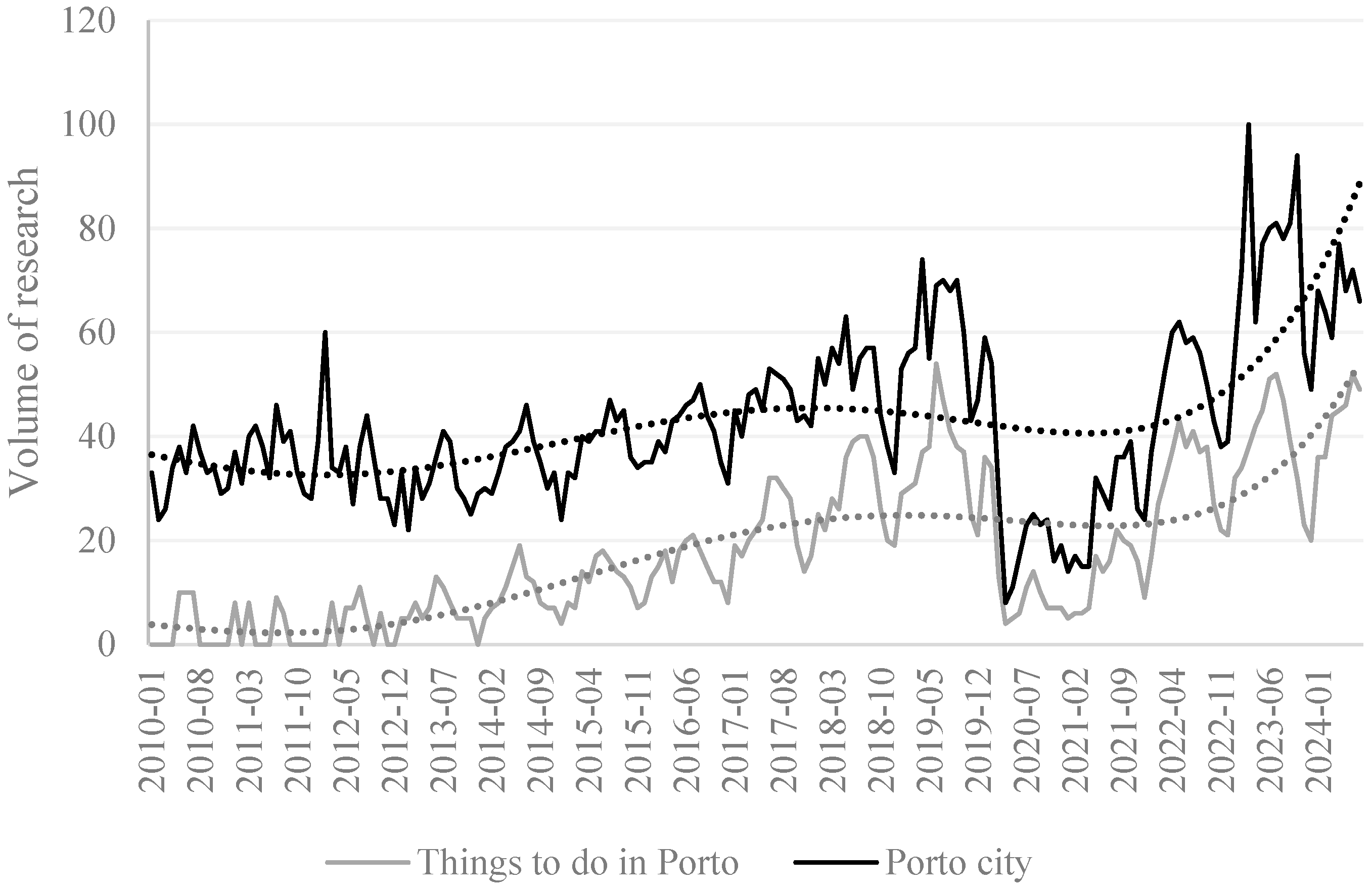





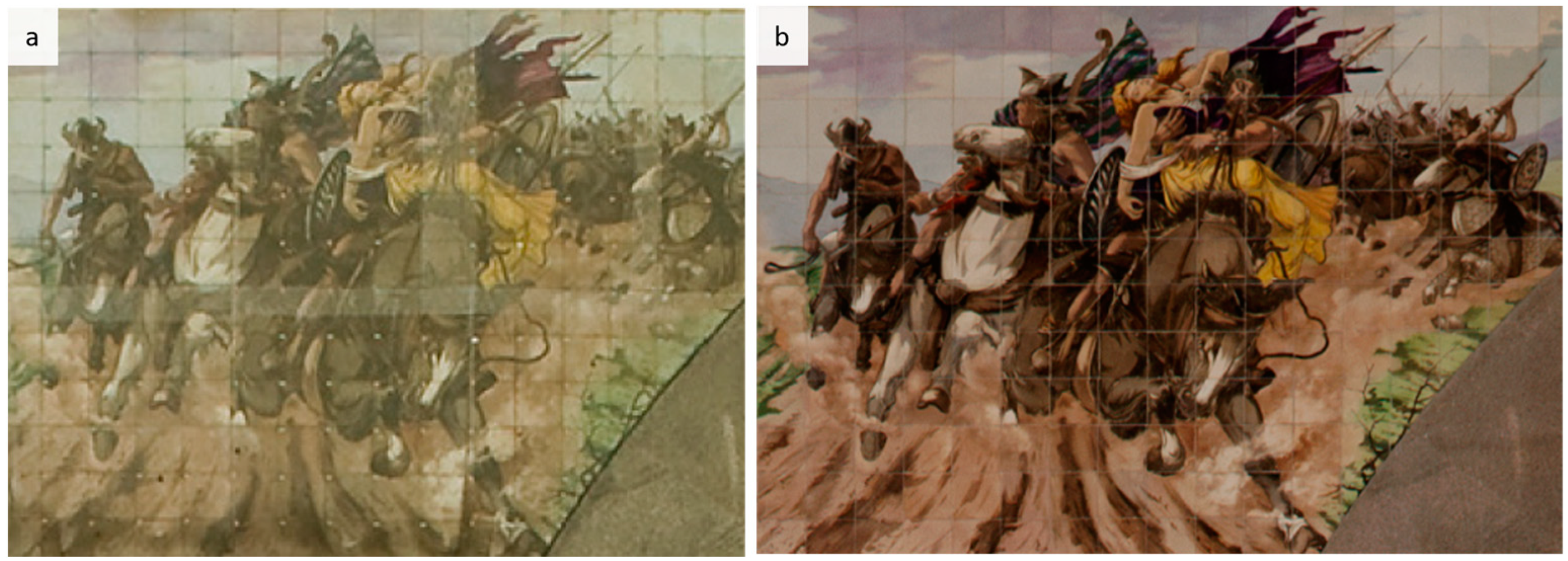
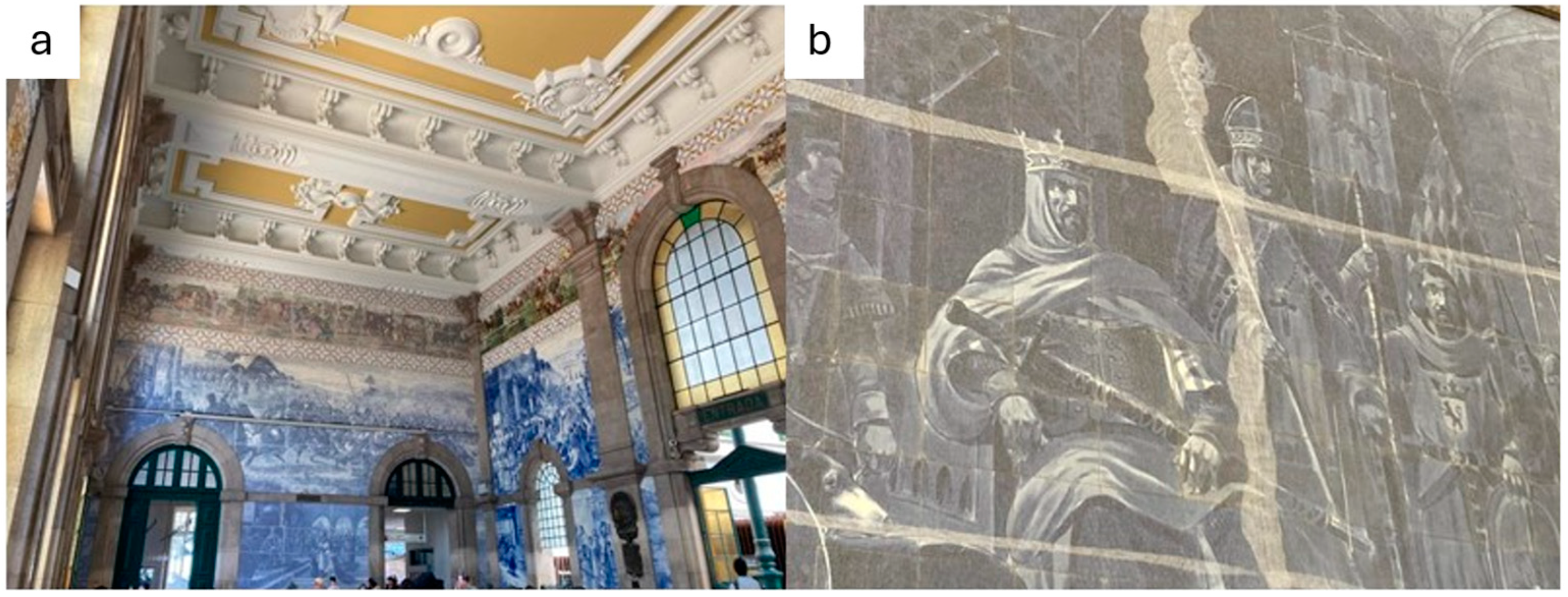




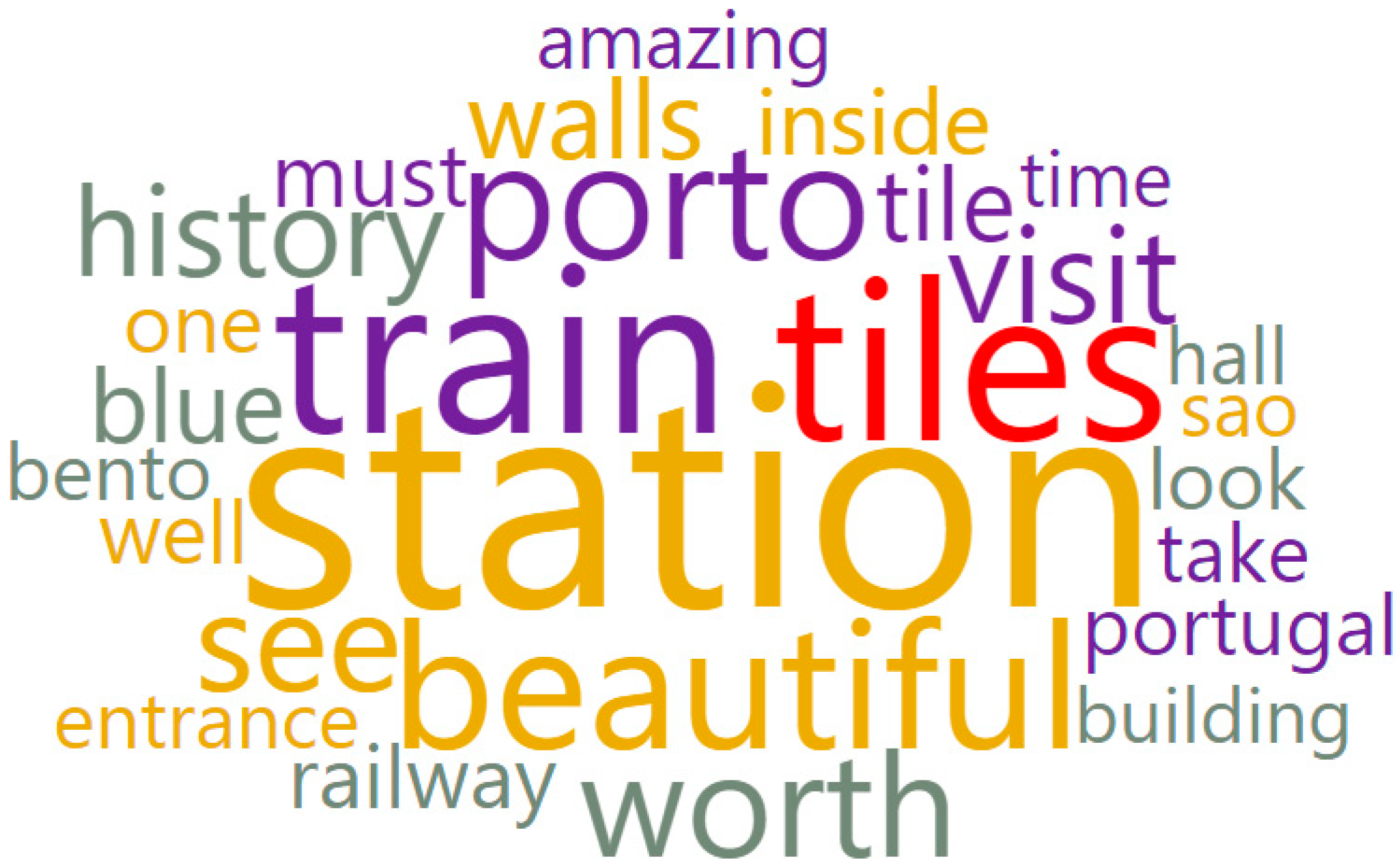


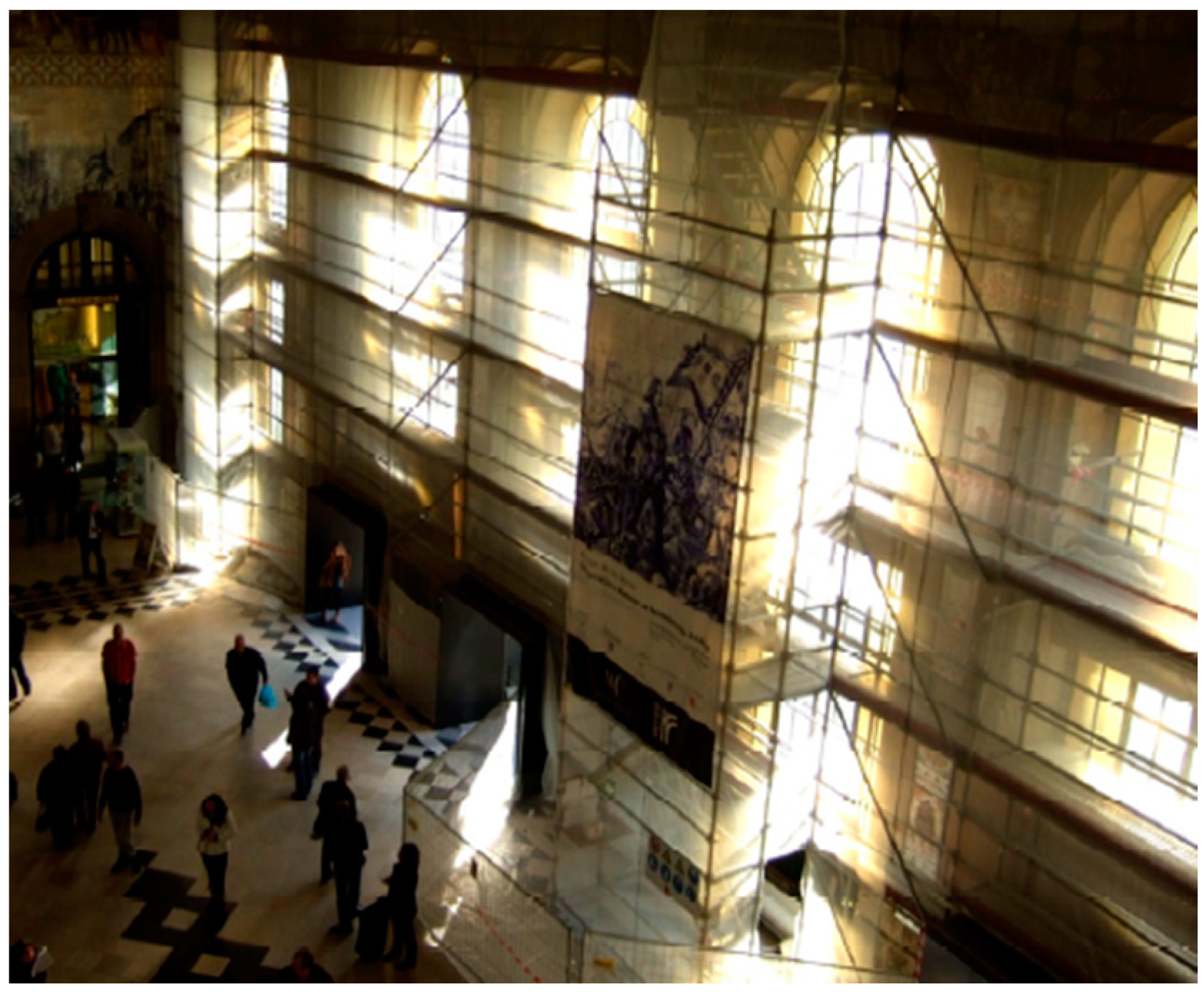
| No. of Tiles | Elevation | Poor Adherence to Support | Fissured/ Fractured | Detached Glaze | Other Situation * | |
|---|---|---|---|---|---|---|
| Partially | Detached | |||||
| 4450 | North | 22.2% | 3.7% | 4.2% | 0.6% | 1.6% |
| 4428 | South | 33.1% | 6.0% | 7.7% | 2.5% | 3.4% |
| 8507 | East | 17.1% | 10.8% | 8.4% | 1.6% | 2.0% |
| 5540 | West | 24.7% | 11.0% | 10.9% | 2.5% | 4.4% |
| No. of Tiles | Survey/ Resettlement of Units | Volumetric and Chromatic Reintegration | Other Treatments * |
|---|---|---|---|
| 4450 | 4.5% | 5.6% | 1.6% |
| 4428 | 6.8% | 11.3% | 3.4% |
| 8507 | 11.8% | 11.2% | 2.0% |
| 5540 | 11.7% | 14.4% | 4.4% |
Disclaimer/Publisher’s Note: The statements, opinions and data contained in all publications are solely those of the individual author(s) and contributor(s) and not of MDPI and/or the editor(s). MDPI and/or the editor(s) disclaim responsibility for any injury to people or property resulting from any ideas, methods, instructions or products referred to in the content. |
© 2024 by the authors. Licensee MDPI, Basel, Switzerland. This article is an open access article distributed under the terms and conditions of the Creative Commons Attribution (CC BY) license (https://creativecommons.org/licenses/by/4.0/).
Share and Cite
Carvalho, C.; Sousa, A.; Silva, A.; Mendes, M.P. User Perceptions and Conservation Practices: A Case Study of Maintenance Strategies at S. Bento Railway Station. Buildings 2024, 14, 3855. https://doi.org/10.3390/buildings14123855
Carvalho C, Sousa A, Silva A, Mendes MP. User Perceptions and Conservation Practices: A Case Study of Maintenance Strategies at S. Bento Railway Station. Buildings. 2024; 14(12):3855. https://doi.org/10.3390/buildings14123855
Chicago/Turabian StyleCarvalho, Cláudia, Alexandre Sousa, Ana Silva, and Maria Paula Mendes. 2024. "User Perceptions and Conservation Practices: A Case Study of Maintenance Strategies at S. Bento Railway Station" Buildings 14, no. 12: 3855. https://doi.org/10.3390/buildings14123855
APA StyleCarvalho, C., Sousa, A., Silva, A., & Mendes, M. P. (2024). User Perceptions and Conservation Practices: A Case Study of Maintenance Strategies at S. Bento Railway Station. Buildings, 14(12), 3855. https://doi.org/10.3390/buildings14123855








